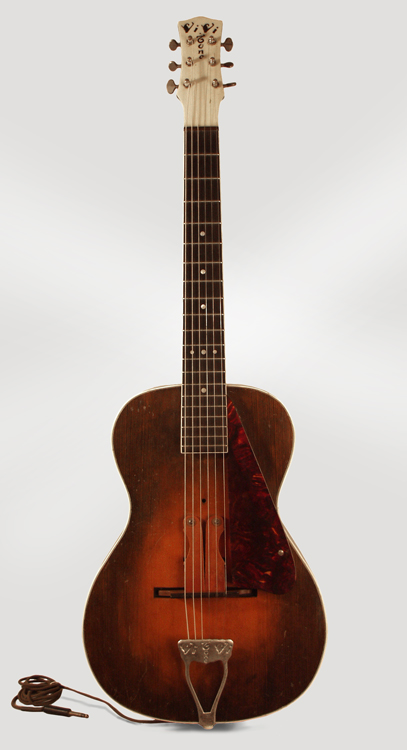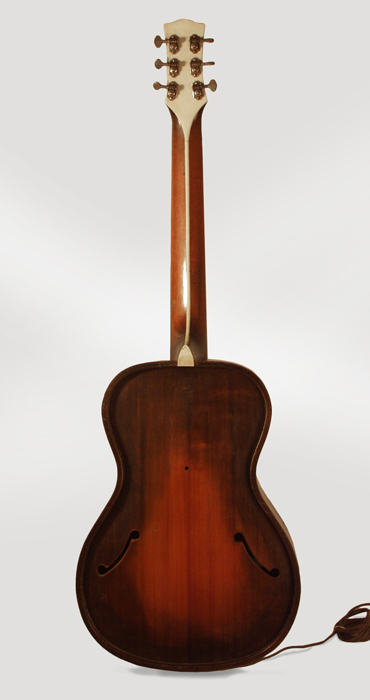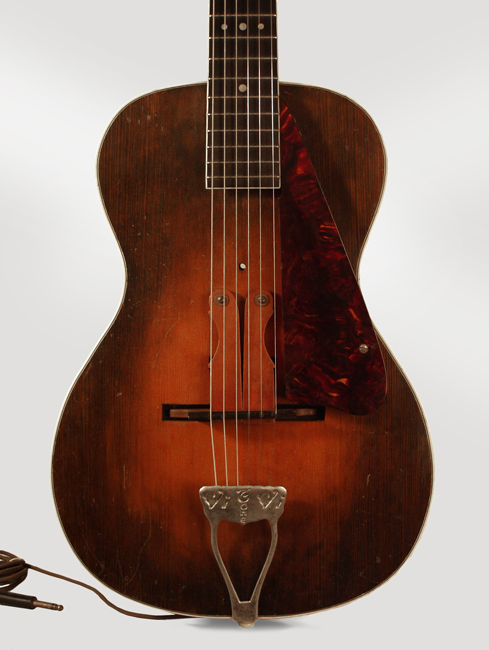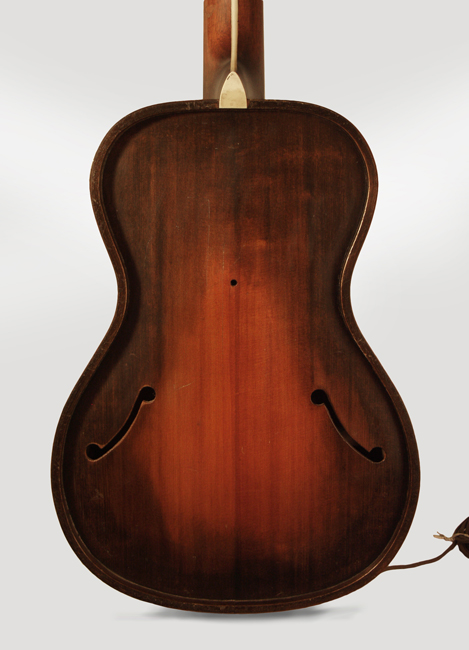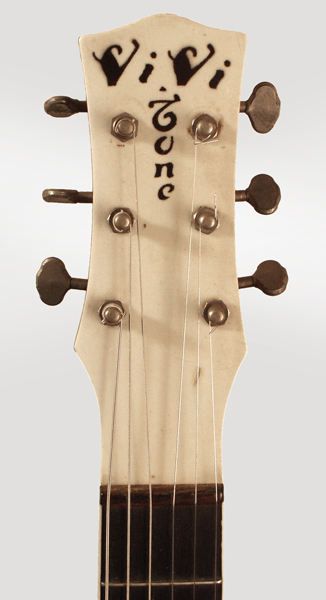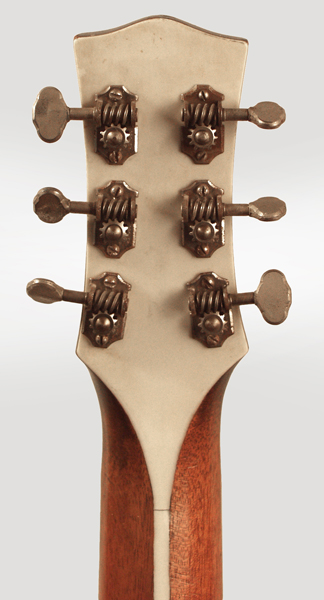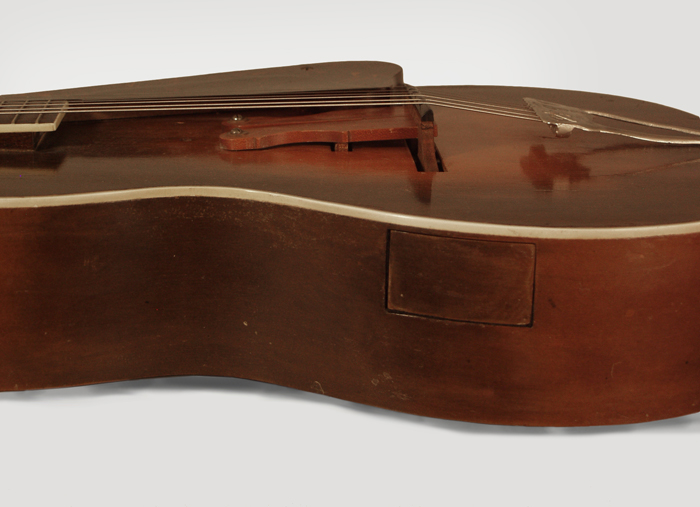Vivi-Tone Acoustic-Electric Guitar , c. 1933
This item has been sold.
Item # 3369
Prices subject to change without notice.
Vivi-Tone Acoustic-Electric Guitar, c. 1933, made in Kalamazoo, Michigan, Cremona Brown Sunburst varnish finish, spruce back and top, maple rims; mahogany neck with ebony fingerboard..
This extremely rare Vivi-Tone electric guitar is a fine example of Lloyd Loar's pioneering efforts in the creation of electric fretted instruments, as well as one of the earliest electric Spanish-style guitars ever made -- predated possibly only by the lost Stromberg-Voisinet electrics that are virtually unknown, and one or two Rickenbacker Electro prototypes.
Loar himself played primarily mandolin family instruments, so one can assume the electric Spanish guitar was a project he had more personal interest in at Vivi-Tone than the Hawaiian style that was the raison d'etre at Rickenbacker. Despite its eccentric design, this is a very well-made and playable instrument with a fascinatingly engineered and complex, if somewhat primitive, pickup system. This was intended as both an acoustic and electric instrument, unlike Vivi-Tone's contemporary plank-like solidbodies.
The general construction is the same as Vivi-Tone's "Acousti-guitars"; a thick-rimmed, standard shaped body with a sunburst finish solid spruce top and back (with f-holes!) and very heavy laminated rims. The neck is shaped somewhat similar to old Gibson necks with a heavy "V" profile, bound ebony fingerboard, and pearl dot inlay. The narrow headstock is ivoroid veneered with a screened "Vivi-Tone" logo and the individual Grover tuners have grained ivoroid buttons. The top is triple bound, and the heelcap is ivoroid. The cast tailpiece carries a very Art Nouveau "Vivi-Tone" logo; the pickguard is heavy tortoise celluloid raised above the rim. The bridge has a compensated ebony cap.
The electronics are mounted in a removable drawer which slides out of the bass side of the rim, with the signal transmitted from the wooden bridge to a metal plate sensed by the coil of the pickup beneath. The bridge has another highly eccentric feature: two pivoting wooden arms screwed at their front ends to the top pass under the bridge top and via a small block of wood transfer vibration to the guitar's back, which was intended to be the primary soundboard! How well this feature works in practice is open to debate, but it is a highly unique concept.
Nearly everything about the Vivi-Tone is unique; Mr. Loar had certainly moved on in his theories since his time at Gibson and created one of the most eccentric, as well as earliest, of all electric guitars.
Overall length is 39 1/8 in. (99.4 cm.), 13 1/8 in. (33.3 cm.) wide at lower bout, and 3 3/4 in. (9.5 cm.) in depth, measured at side of rim. Scale length is 24 1/2 in. (622 mm.). Width of nut is 1 7/8 in. (48 mm.).
Well-preserved with only light-moderate wear overall. There is a small divot in the peghead's plastic facing and a few deep scrapes to the back and rim edges, but overall the wear to the finish is minor. The complex and unique Vivi-Tone pickup unit has been re-wound to the original spec (which was quite a specialist task) using as many original components as possible. The guitar plays quite well, and while the sound is fairly archaic, this is a functional guitar in every sense, as well as a fabulous piece of electric guitar history. Excellent - Condition.
This extremely rare Vivi-Tone electric guitar is a fine example of Lloyd Loar's pioneering efforts in the creation of electric fretted instruments, as well as one of the earliest electric Spanish-style guitars ever made -- predated possibly only by the lost Stromberg-Voisinet electrics that are virtually unknown, and one or two Rickenbacker Electro prototypes.
Loar himself played primarily mandolin family instruments, so one can assume the electric Spanish guitar was a project he had more personal interest in at Vivi-Tone than the Hawaiian style that was the raison d'etre at Rickenbacker. Despite its eccentric design, this is a very well-made and playable instrument with a fascinatingly engineered and complex, if somewhat primitive, pickup system. This was intended as both an acoustic and electric instrument, unlike Vivi-Tone's contemporary plank-like solidbodies.
The general construction is the same as Vivi-Tone's "Acousti-guitars"; a thick-rimmed, standard shaped body with a sunburst finish solid spruce top and back (with f-holes!) and very heavy laminated rims. The neck is shaped somewhat similar to old Gibson necks with a heavy "V" profile, bound ebony fingerboard, and pearl dot inlay. The narrow headstock is ivoroid veneered with a screened "Vivi-Tone" logo and the individual Grover tuners have grained ivoroid buttons. The top is triple bound, and the heelcap is ivoroid. The cast tailpiece carries a very Art Nouveau "Vivi-Tone" logo; the pickguard is heavy tortoise celluloid raised above the rim. The bridge has a compensated ebony cap.
The electronics are mounted in a removable drawer which slides out of the bass side of the rim, with the signal transmitted from the wooden bridge to a metal plate sensed by the coil of the pickup beneath. The bridge has another highly eccentric feature: two pivoting wooden arms screwed at their front ends to the top pass under the bridge top and via a small block of wood transfer vibration to the guitar's back, which was intended to be the primary soundboard! How well this feature works in practice is open to debate, but it is a highly unique concept.
Nearly everything about the Vivi-Tone is unique; Mr. Loar had certainly moved on in his theories since his time at Gibson and created one of the most eccentric, as well as earliest, of all electric guitars.
Overall length is 39 1/8 in. (99.4 cm.), 13 1/8 in. (33.3 cm.) wide at lower bout, and 3 3/4 in. (9.5 cm.) in depth, measured at side of rim. Scale length is 24 1/2 in. (622 mm.). Width of nut is 1 7/8 in. (48 mm.).
Well-preserved with only light-moderate wear overall. There is a small divot in the peghead's plastic facing and a few deep scrapes to the back and rim edges, but overall the wear to the finish is minor. The complex and unique Vivi-Tone pickup unit has been re-wound to the original spec (which was quite a specialist task) using as many original components as possible. The guitar plays quite well, and while the sound is fairly archaic, this is a functional guitar in every sense, as well as a fabulous piece of electric guitar history. Excellent - Condition.
